Should the EU Pursue a Strategic Ginseng Policy? Trade Dependency in the Brave New World of Geopolitics
Published By: Oscar Guinea Vanika Sharma
Subjects: EU Trade Agreements European Union
Summary
Political leaders all over the world are calling for strategic autonomy. The removal of critical trade dependencies has become a guiding principle in most policy proposals, including the EU’s new industrial strategy. In making these decisions, it is important for policymakers to understand the reasons behind why shortages of critical goods and technologies have emerged in the first place. The instruments that new policies cerate should respond to real problems, not invented ones. For instance, if shortages are due to temporary mismatches of supply and demand, most of them will be fixed without the need of any policy intervention. On the other hand, shortages can also be engineered by countries using their dominance in the production of certain goods to coerce other countries. As the EU experienced first-hand after the Russian war on Ukraine in 2022, the concentration of market power in the production of any product carries geopolitical risks. For that purpose, it is crucial to understand the nature of trade dependencies.
This policy brief presents indicators and a conceptual framework to measure trade dependency. The framework consists of two indicators: the first measures the share of EU imports from outside the EU over EU production proxied as the sum of imports and exports, while the second indicator considers the market concentration using the Herfindahl-Hirschman index (HHI). It then applies this framework to EU trade with the rest of the world in 2020 and elaborates on the product categories and partner countries behind these dependencies. From a total of more than 9,000 product categories, there were only 233 products that could be classified as dependent within our framework. In terms of values, they represented 1.5% of EU total imports or €50 billion. The major suppliers of these products to the EU were China, United States, Russia, and the United Kingdom. Imports of hydrocarbons from Russia are part of this list of trade dependencies, but so are many other goods which are not of strategic importance.
A policy intervention should be tailored to the specific product and the specific export country. Given the small size of the EU imports in which the EU can be considered dependent, it is not advisable to base Europe’s new industrial policy on a general fear of dependency and apply new policies in many sectors. Many of these products are easy to substitute and the economy can function without them. For the select few products where dependency is an economic concern, our paper explores different measures that the EU can put in place to lower trade dependency and how this dependency can be reduced through international trade.
1. Breaking Free or Breaking Bad
Russia’s war on Ukraine has opened a new discussion about Europe’s energy dependence on Russia. At the time of writing there is no embargo on gas and oil from Russia, but other sanctions against Russia are affecting the supply of the hydrocarbons. There is also a moral case for rapidly reducing Europe’s hydrocarbon imports from Russia since this trade is propping up the Russian state and undermines the effectiveness of the economic and financial sanctions. The current EU plan – REPowerEU – aims for a reduction of gas imports and supply vulnerability during 2022, leading to a substitution of gas imports from Russia over a few years.
Beyond gas and oil, is there a general case to be made for being alarmed about Europe’s trade dependence? Some seem to think so. Afraid of product shortages, several European capitals are calling for the re-shoring of supply chains. In its 2020 industrial strategy, the European Commission vowed “to make the most of localization as an opportunity to bring more manufacturing back to the EU in some sectors”[1]. Its most recent effort of this kind is the European Chips Act, which aims to double the production of semiconductors within the EU by 2030 and secure critical supplies during a crisis. These concerns are symptoms of a larger debate on EU strategic dependencies and the need for modern tools for the EU to safeguard itself against the risk of supply chain disruptions. This debate is not just European but global and similar arguments and policies are being considered in many capitals, including Washington, DC[2] and Beijing[3].
For policymakers, it’s important to understand the reasons behind these shortages in order to respond with effective measures. If shortages are due to temporary mismatches of supply and demand, most of them will be fixed without the need of any policy intervention. The same conclusion holds for other random events like a volcano eruption[4], an earthquake[5], or another pandemic. Markets will take care of production after the event, but the principal way to cope with the shock is for countries and companies to have inventory stocks and contingency plans for ramping up production.
The shortage of medical personal protective equipment (PPE) at the beginning of the COVID-19 pandemic is a good example. At the peak of the shortage, the situation was dramatic. EU citizens were alarmed by images of doctors using plastic bags as medical gowns. It took a couple of months for the situation to improve but eventually the shortages were resolved. A combination of higher imports and domestic production helped meet the sudden increase in demand. EU imports from outside the EU were more responsive to this unexpected change than intra-EU trade. Figure 1 below shows EU imports of protective garments like facemasks, gloves, and medical gowns[6] from outside the EU (extra-EU imports) and from within the EU (intra-EU imports) in 2020. In April 2020, EU imports of protective garments from outside the EU became 55% of EU total imports. The increase in the share of extra EU imports of protective garments was underpinned by growth rates in April, May, and June that averaged 67% while purchases of protective garment during these three months among EU countries (intra-EU imports) went down by 8% as compared to 2019. The figure shows that thanks to international trade Europe became more resilient.
Figure 1: Share of intra and extra-EU imports of protective garments (2020)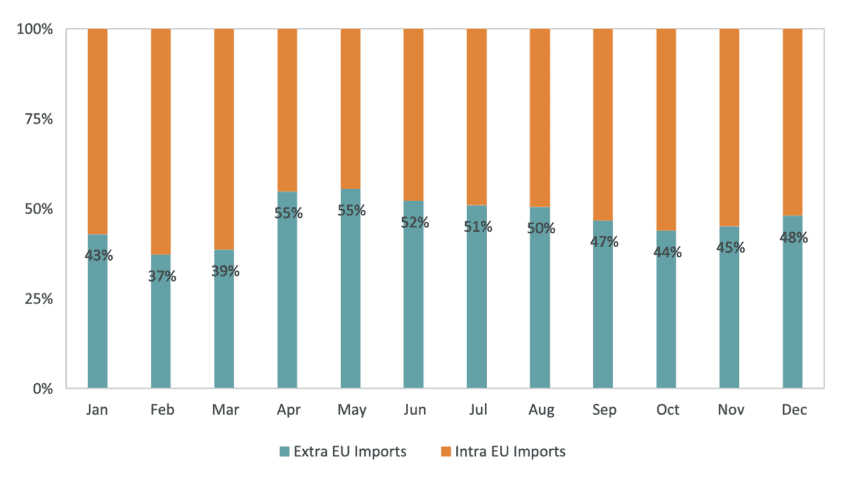 Source: Eurostat, COMEXT, authors’ calculations.
Source: Eurostat, COMEXT, authors’ calculations.
A second example of shortages affecting the EU is the current lack of semiconductors. In February 2022, the EU unveiled its Chips Act which includes tools to respond to shortages and support domestic production. The Act is part of the EU’s goal to double its share of the global chip market to 20% by 2030. To achieve this goal, the European Commission and national governments would spend €11 billion to build three pilot facilities for any company to use and member states and businesses are expected to invest an additional €32 billion by 2030. With these resources the EU will support pilot lines which will allow companies to turn new technologies into scale production. This public funding to subsidise the production of semiconductors comes with conditions attached. One of them being that the EU will have the power to stop exports of semiconductors in case of shortages. As pointed out by Alan Beattie of the Financial Times, export restrictions in themselves create the justification for subsidising domestic production: “if everyone else is building chip factories and preparing to block the exits you’d better do so too”[7].
However, the policy of subsidising the domestic production of semiconductors is not a guaranteed success. The semiconductor industry is characterised by cycles of shortages and glut. Even though we are in a period of scarcity, there are planned investments from major companies like the Taiwan Semiconductor Manufacturing Company (TSMC), Samsung Electronics, and Intel[8] as well as public money from Japan, South Korea, China, and the United States[9]. While semiconductors will be in big demand in the future[10], growth rates may fall as businesses have already filled their stocks and by the time new factories in the EU are up and running, the market will look different. In the race to produce more chips, the EU’s goal is not self-sufficiency but to bring larger chunks of the manufacturing of semiconductors within the EU. The EU already has a good position in the early parts of the supply chain, in research and advanced lithography for example, but to meet its 20% target, the EU will have to lure foreign companies with European tax-payers money. These investments will increase Europe’s foothold in the global semiconductor industry but having factories will not necessarily solve supply chain risks and future shortages since the industry is complex, interdependent, and cyclical.
Not all shortages can be explained by the disconnection between supply and demand or arise because of random events like natural disasters. Shortages can also be engineered by countries willing to use their monopoly power in the production of certain goods. This is important as the general underlying theme guiding policymakers is not just lack of trust in supply chains but also fear of dependency. In international trade, the issue of dependency appears when a company, or a country, becomes the main provider of certain goods or services and uses this power to impose its market conditions or achieve its political goals.
This has been a crucial point of discussion in the current context of the Russian war on Ukraine. Europe, along with its allies and partners, has responded with an unprecedented package of sanctions that will have deep effects on the Russian economy. For products where Russia faces no strategic dependencies on the EU, it will be easier to find alternate suppliers, however, for products where dependencies exist, especially strategic dependencies, Russia will feel the squeeze of the West. Many products imported by Russia from the EU are relatively sophisticated which makes finding alternative suppliers for Russia even more difficult. At the same time, the EU finds itself unable to stop EU imports of oil and gas from Russia, as the EU does not have alternative suppliers to provide the amounts of energy that it requires.
Fear of dependency has become the most powerful engine propelling EU industrial policy. In the words of its chief architect, the European Commissioner for the Internal Market, Thierry Breton “we clearly need to diversify and reduce our economic and industrial dependencies”[11]. From the new EU Pharmaceutical Strategy to the European Chips Act, lowering EU dependencies with the rest of the world has turned into the main justification for public policy. In the European Commission communication that outlines the new EU industrial strategy[12], the word dependencies appeared 42 times and resilience 22 times while market failure was mentioned once, and externality did not feature at all. Trade dependencies and shortages are the villains in Europe’s motivation for a new EU industrial policy.
If fear of dependency is the main rationale behind the EU industrial policy, it is important to ask: how big is this problem? If the EU is dependent on some products made abroad, which are these products and where do they come from? And once these products have been identified, what can policymakers do to reduce this dependency? This policy brief presents the indicators and the conceptual framework to measure trade dependency. Then it applies this framework to EU trade with the rest of the world in 2020. Finally, it explores which measures can be put in place to lower trade dependency and discusses whether this dependency can be reduced through international trade.
We conclude that, given the small size of the EU imports in which the EU can be considered dependent, it makes no sense to base Europe’s new industrial policy on a general fear of dependency. The policies required need to be much more specific to certain products (e.g., oil and gas) and certain export countries (e.g., Russia). Moreover, many of these products are easy to substitute and the economy can function without them – like our imports of ginseng and bamboo. Strategic policies for such goods do not hold up. Some may recall that France was mocked for running a ‘strategic yogurt policy’ in 2005 after some politicians blocked a foreign takeover of Danone. Just like France did not need a “yogurt strategy” then,[13] the EU does not now need an industrial strategy to produce bamboo or a strategic ginseng policy.
[1] European Commission, A New Industrial Strategy for Europe, COM (2020) 102 final, Retrieved from https://ec.europa.eu/info/sites/default/files/communication-eu-industrial-strategy-march-2020_en.pdf.
[2] Bloomberg (2021, February 24). Biden Says Americans Should Never Face Any Sort of Supply Shortage. Bloomberg, Retrieved from https://www.bloomberg.com/news/videos/2021-02-24/biden-says-americans-should-never-face-any-sort-of-supply-shortage-video
[3] China Power Team. “Will the Dual Circulation Strategy Enable China to Compete in a Post-Pandemic World?” China Power. December 15, 2021. Updated December 16, 2021. Accessed January 24, 2022. https://chinapower.csis.org/china-covid-dual-circulation-economic-strategy/
[4] Wearden, G. (2010, April 20). Nissan and BMW car production hit by volcano disruption. The Guardian, Retrieved from https://www.theguardian.com/business/blog/2010/apr/20/nissan-suspends-car-production-volcano-ash-cloud
[5] Inoue, H., & Todo, Y. (2017). Mitigating the propagation of negative shocks due to supply chain disruptions. VoxEU. Retrieved from https://voxeu.org/article/natural-disasters-and-supply-chain-disruptions-mitigating-propagation-negative-shocks
[6] The full list of COVID-19 related goods can be found in Eurostat. EU trade since 2015 of COVID-19 medical supplies by categories (DS-059283)
[7] Beattie, A. (2022, February 7). EU enters the chip subsidy game. Financial Times, Retrieved from https://www.ft.com/content/e8559e54-33f7-47a4-8401-923fab88f219
[8] Thornhill, J. (2022, January 27). The scramble for semiconductors is our era’s industrial Great Game. Financial Times, Retrieved from https://www.ft.com/content/c77d15e3-af1f-48fb-b349-202e095a7d40
[9] Beattie, A. (2022, February 7). EU enters the chip subsidy game. Financial Times, Retrieved from https://www.ft.com/content/e8559e54-33f7-47a4-8401-923fab88f219
[10] Tanaka, A., Ting-Fang, C., Li, L. (2021, December 20). Chipmakers’ nightmare: will shortages give way to a supply glut? Financial Times, Retrieved from https://www.ft.com/content/9f6dcb43-fe9f-4880-a6b4-f6df5ece979e
[11] European Commission (2020, June 10). For a united, resilient and sovereign Europe. European Commission, Retrieved from https://ec.europa.eu
[12] Updating the 2020 New Industrial Strategy: Building a stronger Single Market for Europe’s recovery. European Commission. COM (2021) 350 final.
[13] The Economist (2020, October 3). Charlemagne. The revenge of strategic yogurt. The Economist.
2. Measuring Dependency in International Trade
EU imports are defined as dependent when the imported product fulfils two conditions simultaneously. The first condition is that EU imports from outside the EU represent a considerable share of EU’s production which is proxied as the sum of intra-EU imports – which are the goods that EU member states buy and sell among themselves and by definition is also equal to intra-EU exports – and EU exports to outside the EU (extra-EU exports). The second condition is that the goods that the EU buys mostly from outside the EU must be supplied by only a few countries.
To define the first condition, EU imports from outside the EU must be equal to or higher than 75% of EU total imports and extra-EU exports. We believe that this threshold is sufficient as EU companies below 75% still produce 25% of the EU total imports and extra-EU exports which means that EU businesses have the know-how to produce that product and can scale up production in the event of a crisis. And keep in mind that imports and exports are just one part of the supply of a product: European countries also produce for their own domestic consumption. Hence, imports within the EU and exports outside the EU are lower than EU production since part of EU production is not sold to other EU and non-EU countries but consumed in the EU country where it is produced. So, this indicator underestimates EU production capacity.
The second condition is measured through the Herfindahl–Hirschman Index (HHI). In our framework, when the HHI is equal to or larger than 0.25, the imported product qualifies as dependent. This threshold of 0.25 is also used in competition policy to define a market in which production is highly concentrated on a few suppliers. When calculating the HHI, we include the market share of intra-EU imports and extra-EU exports, but we only sum the square of the market share in EU total imports and extra-EU exports of non-EU countries since we want to identify those products in which the EU is dependent on non-EU countries.
A similar analysis was done by the European Commission, and the results have been used to motivate a more muscular industrial policy. However, our analysis differs from the Commission in four important aspects. The first one is that we use a higher level of product disaggregation. Our analysis assesses dependency in close to 9,000[1] product categories while the European Commission focuses on 5,000 product categories[2]. The second difference is that we account for the EU production that is exported outside the EU directly in our two indicators by including extra-EU exports into the first and the second indicator. The third difference are the thresholds that define a product as dependent, and the indicators used to measure trade dependency. Our first indicator (the value of EU total imports and extra-EU exports coming from outside the EU) is set at 75% while the European Commission uses a threshold of 50% and excludes the EU production that is exported outside the EU. Our second indicator, the HHI, is a proxy for market concentration and uses a threshold of 0.25 when the European Commission used a threshold of 0.4 and does not consider intra-EU imports and extra-EU exports in its calculation of the HHI. The fourth difference is that we use two indicators while the European Commission uses an additional indicator for a product to qualify as dependent. We believe this additional indicator – which defines a product as dependent when EU exports are lower than EU imports – is problematic for two reasons. First, given the aggregation in trade statistics, there are different types of products included in each product category[3]. As a result, the imported and exported products within one product category are not necessarily the same products. The second reason is that, conceptually, we disagree with the idea that there is a problematic dependence just because EU imports are greater than EU exports.
Our indicators borrow from a conceptual framework developed in a previous study by one of the authors of this policy brief.[4] In that study, dependency was divided into four quadrants along two indicators: the share of EU total imports coming from outside the EU and the HHI, for which corresponding thresholds were 75% and 0.25. We have updated this framework by adding extra-EU exports to both indicators so the EU production that is exported outside the EU is considered. Figure 2 visualises the model. In quadrant one, we include those goods with high extra-EU imports and high concentration of suppliers. In quadrant two, we include goods with low or moderate extra-EU imports and high concentration of suppliers. In quadrant three, we include goods with low or moderate extra-EU imports and low concentration of suppliers. Finally, in quadrant four, we include goods with high extra-EU imports and low concentration of suppliers. To summarise, quadrant one includes goods that qualify as trade dependent while quadrant three includes goods where the EU has low dependency. Goods in quadrant two and four have limited dependency because EU imports from outside the EU are relatively low or because the EU has a large pool of external suppliers from which to buy the imported goods.
Figure 2: Import dependency conceptual framework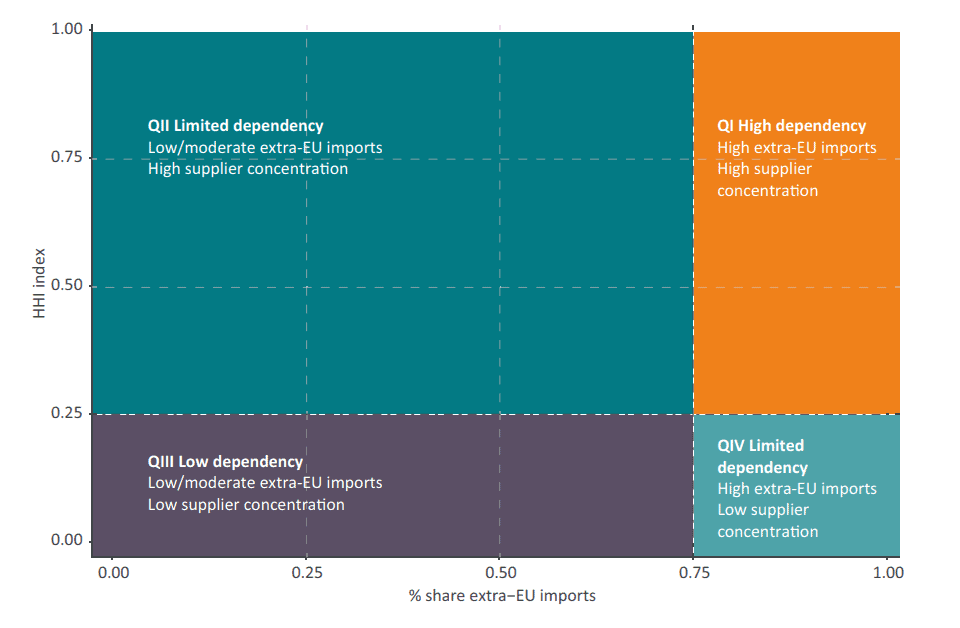
[1] Product codes of confidential trade were excluded from the study.
[2] European Commission (2021). Strategic dependencies and capacities. Commission Staff Working Document. Retrieved from https://ec.europa.eu/info/sites/default/files/swd-strategic-dependencies-capacities_en.pdf
[3] Cernat, L. (2014). Towards “trade policy analysis 2.0”: From national comparative advantage to firm-level trade data. VoxEU. Retrieved from https://voxeu.org/article/towards-trade-policy-analysis-20
[4] Guinea, O., & Espés, A. (2021). International EU27 pharmaceutical production, trade, dependencies and vulnerabilities: a factual analysis. Report, ECIPE.
3. Calculating the EU Trade Dependency
We gather more than 124,000 observations of EU imports and exports from close to 9,000 product categories in 2020 to assess in which products the EU is dependent on other countries. In that year, the EU imported a total of €4.3 trillion[1], 38% was imported from outside the EU (i.e. extra-EU imports) and 62% was imported from within the EU (intra-EU imports), and exported a total of €4.5 trillion. The result of our analysis is presented in Figure 3.
Figure 3 shows that 233 products representing 1.2% (€50 billion)[2] of EU total import values can be defined as dependent in our framework (quadrant one)[3]. Table 1 in the Annex lists all the 233 products, their import values, and main supplying country to the EU. The graphical representation of the analysis also provides additional transparency as to what would happen if we changed the thresholds that define a product as dependent. For instance, if our first indicator (the share of EU total imports and extra-EU exports coming from outside the EU) changes from 75% to 50%, the number of products deemed as dependent will increase from 233 to 461 representing 2% of EU total import values.
Similarly, there were 8,454 products with import values worth €1.4 trillion in quadrant three where the share of EU imports of the products was below 75% and the HHI index was also under 0.25. These represent 33% of the EU’s total imports in value[4]. In quadrant two, where the share is less than 75% and HHI is greater than 0.25, there were 228 products representing 0.8% of EU total value of imports. Finally, in quadrant four, with the share of EU imports greater than 75% and HHI less than 0.25, there were 70 products worth 3.9% of EU total value of imports.
Figure 3: EU import dependency (2020)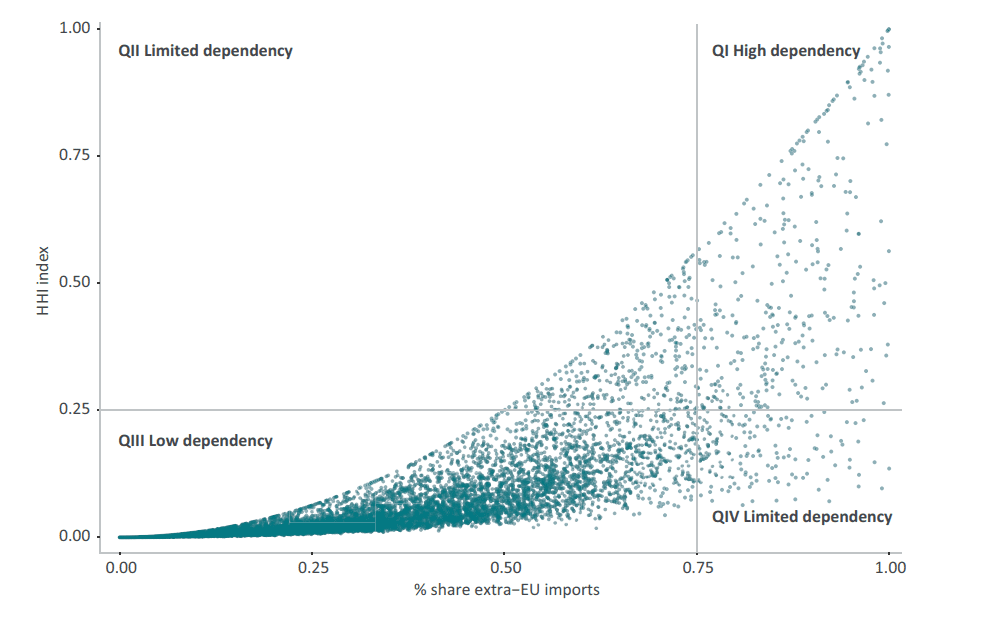 Source: Eurostat, COMEXT, authors’ calculations.
Source: Eurostat, COMEXT, authors’ calculations.
If we focus our attention on quadrant one which shows the products where the EU is dependent on other countries, Figure 4 shows that some of these products are not critical to the EU economy, either because they can be easily substituted or because the economy can operate without them. These are, for example, agriculture and beverages, textiles[5], plastic and wood products, and a mix of manufacturing products like artificial flowers, wigs, or watches. In other cases, like minerals, fuels, or some spirits, products qualify as dependent because they are only extracted – and imported – from certain geographical areas. Other goods belonging to the manufacturing and the chemical and pharmaceutical industry such as insulin and liquid crystal could be more difficult to replace. As can be seen in Figure 4, minerals and fuels, chemical and pharmaceuticals, and machinery and vehicles represent 34% of the product categories and the same percentage in value of extra EU imports from the 233 product categories defined as dependent.
Figure 4: EU imports of dependent products (QI) in 2020 by economic sector[6] 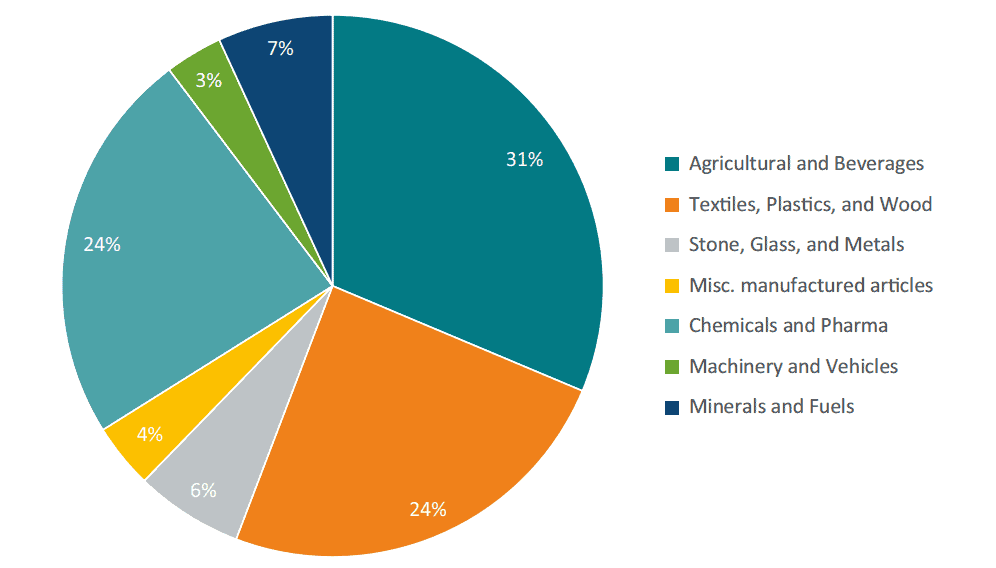 Source: Eurostat, COMEXT, authors’ calculations.
Source: Eurostat, COMEXT, authors’ calculations.
Figure 5 and Figure 6 show the largest suppliers of these 233 product categories in terms of the share of import values and the share of product categories. The most important countries behind these 233 products were China (51 products valued at €23.4 billion), Russia (10 products valued at €7.9 billion), and the United States (30 products valued at €3.5 billion). The EU is also dependent on the imports of certain products from Switzerland, the United Kingdom, Indonesia, Morocco, Philippines, India, South Korea, Malaysia, Turkey, Canada, and Guinea. As mentioned, Table 1 in the Annex includes the full list of the 233 product categories and the country name of the most important supplier for each product category.
Figure 5: Share of EU imports value of dependent products (QI) in 2020 by country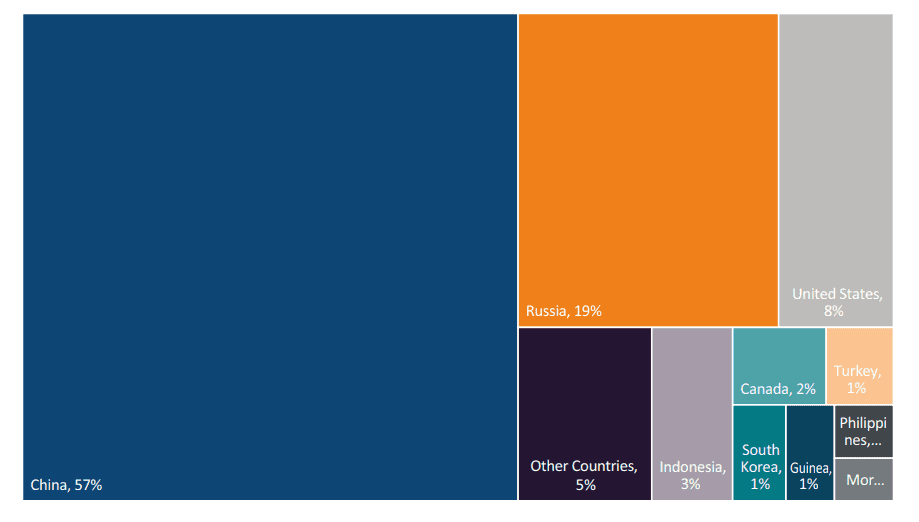 Source: Eurostat, COMEXT, authors’ calculations.
Source: Eurostat, COMEXT, authors’ calculations.
Figure 6: Share of number of EU dependent products (QI) in 2020 by country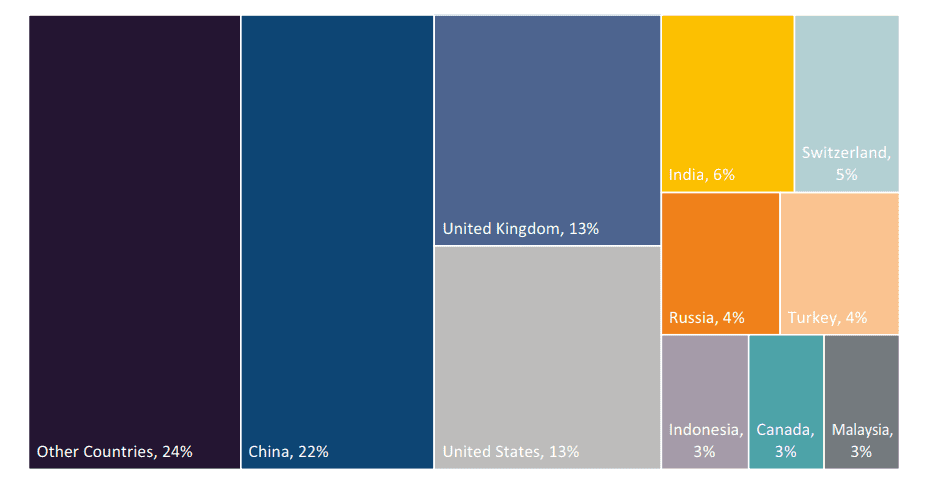 Source: Eurostat, COMEXT, authors’ calculations.
Source: Eurostat, COMEXT, authors’ calculations.
China stands out for two reasons. Firstly, China is the largest source of goods on which the EU is dependent. Secondly, according to some analysts[7], China is willing to utilise its dominant position in the production of certain goods, as well as the size of its economy, to reach its political goals[8]. The actions taken by the Chinese Government against Lithuania as a response to the strengthening of diplomatic ties between Lithuania and Taiwan are a good example[9].
Nonetheless, the threat of the Asian giant is also relative. As mentioned, the EU is dependent on the production of goods coming from China in 51 product categories that represent 0.5% of EU total imports. Table 2 in the Annex presents these 51 products in more detail. The table includes many agricultural goods like bamboo and ginseng as well as textiles such as silk, that can hardly be considered vital for the European economy. At the same time, the EU is also dependent on Chinese chemicals and pharmaceutical ingredients, rare earths like scandium and some machinery that could impact the European economy to a greater extent. Still, these are only 18 product categories, equal to €1 billion and representing 0.02% of EU total imports.
Russia also stands out as one of the main countries in which the EU is dependent for some products. In numbers, the EU depends on Russia for the supply of 10 products, 4% of the 233 product categories, but 19% in terms of the import value of these 233 products. These products are mostly gas and fuels[10]. The dependency on gas and fuels from Russia is now at the centre of discussions about sanctions against Russia. The EU has been unable to impose heavier sanctions on Russia’s main export and source of income – oil and gas – because of its dependency on Russia for these products. On the other hand, Russia has also nurtured strategic dependencies from the EU. In a recent analysis by ECIPE[11], it was found that in 2020, there were 1,716 product categories (out of 4,385) with a value of €57 billion (28% of Russian total imports) for which at least half of Russia’s imports came from the EU and the US.
[1] This is the trade value after excluding product codes with confidential trade values.
[2] As a comparison the European Commission found that the EU can be considered highly dependent on 137 products that represent 6% of extra-EU import value of goods. Source: European Commission (2021). Strategic dependencies and capacities. Commission Staff Working Document. The import value of our 233 products falling in our category of dependency is equal to €50 billion which represents 2.9% of extra-EU imports (€1,710 billion).
[3] An early analysis of this question was published for the op-ed. Guinea, O., Pérez del Puerto, I. (2022, January 17). The phantom menace that threatens European trade. El País. The calculations for that article were based on a methodology that has been updated for this paper and the numbers have changed.
[4] We present our results as a percentage of EU total imports and extra-EU exports which is equal to the sum of imports from within the EU (intra-EU imports), imports from outside the EU (extra-EU imports), and exports to countries outside the EU. The value of each quadrant as a percentage of extra-EU imports is the following: QI (3%); QII (2%); QIII (85%); QIV (10%).
[5] The Textiles, Plastics, and Wood sector includes two product categories: Cotton Gauze – 58030010; and Single-use gowns made up of nonwovens, of a kind used by patients or surgeons during surgical procedures – 62101092 which can be vital products in case of medical emergency.
[6] The product categories in Annex Table 1 were aggregated into seven economic sectors. The product categories belonging to each economic sector started with the following two digits: Agriculture and Beverages – 01, 02, 03, 04, 07, 08, 09, 10, 12, 14, 15, 16, 20, 22, 23; Mineral and Fuels – 25, 26, 27; Chemicals and Pharmaceuticals – 28, 29, 30, 32, 33, 37, 38; Textiles, Plastics, and Wood – 39, 40, 41, 43, 44, 46, 47, 50, 51, 52, 53, 54, 55, 58, 62, 63; Misc. Manufactured Articles – 65, 67, 91, 92; Stone, Glass, and Metals – 68, 70, 71, 72, 79, 81; Machinery and Vehicles – 84, 85, 87, 90.
[7] Hackenbroich, J. (2021). Chinese sanctions: How to confront coercion and avoid a squeeze on Europe II. European Council on Foreign Relations. Retrieved from https://ecfr.eu/article/chinese-sanctions-how-to-confront-coercion-and-avoid-a-squeeze-on-europe-ii/
[8] Other countries apart from China have used coercion to impose their political views. For instance, United States sanctions on Iran have impacted EU companies. However, the United States and other economies in Figure 3 and 4 like the United Kingdom, are market economies that follow similar principles to the EU economy, where the separation of political and economic power takes precedence.
[9] Moens, B., Leali, G. (2022, January 13). EU resorts to bluff in its trade conflict with China. Politico, Retrieved from https://www.politico.eu/article/eu-capitals-play-game-of-bluff-poker-about-quick-anti-china-action/
[10] These product codes are: 27101931 Gas oils of petroleum or bituminous minerals for undergoing a specific process; and 27101951 Fuel oils of petroleum or bituminous minerals for undergoing a specific process.
[11] Erixon, F., Guinea, O., Sharma, V., Montero, R.Z., (2022, March). Russia Import Dependency Problem. ECIPE. Retrieved from: https://ecipe.org/blog/russia-import-dependency-problem/
4. Lowering EU Trade Dependency
Our analysis shows that EU import dependency on non-EU countries may not be as large as expected. The value of imported goods defined as dependent was €50 billion or 1.2% of EU total imports. Moreover, these 233 product categories include many different kinds of products – not all vital for the EU economy – from different trade partners – not all of them unreliable partners. However, big or small, there are some products in which the EU is dependent on other countries for critical supply chains to work. To lower trade dependency with third countries, the EU has some policy options as suggested below:
1. EU businesses and governments can choose to build inventories of the dependent products, so that they do not face shortages in times of crisis. This option, however, requires a turnaround of the stock for perishable products. In the long-term, even non-perishable products need to be replaced and this replacement needs to be done progressively to avoid creating the spikes in demand that the inventory aims to prevent. Stocks can soften the blow and reduce the likelihood of shortages but are unlikely to make up for the sudden increase in demand as a result of a shock. Finland, which had built up stocks of medical goods over the years[1], still saw its imports of protective garments increase by 18% in 2020 as compared to the year before.
2. The EU and EU member states could incentivise businesses to produce the dependent products within the EU. However, as it is the case with the new European Chips Act, subsidised domestic production is costly, both directly in terms of the funds spent on the subsidy and indirectly as it absorbs capital and labour from other sectors where the EU is more competitive[2].Moreover, subsidising domestic production may not make the EU more resilient to shortages. Replicating the supply chain of any product is a very complex and expensive enterprise[3]. The EU can subsidise parts of the supply chain. As a result of these subsidies, the proportion of a product that is produced within the EU will increase, but the risks of shortages will not disappear; they will be in other parts of the supply chain.Critical knowledge of the EU production capacity is of essence as the EU may already have sufficient production capacity to compensate for sudden shortages of a particular product. COVID-19 medical goods are a good example. There was no COVID-19 related product where the EU had less than a 20% market share, which means that, as stated by former German Chancellor Angela Merkel, there is already a “pillar of domestic production”[4]. The knowhow exists, and it is possible to ramp up production if other countries were to cut the EU off. [5]
3. The EU could lower its dependency by buying the products in which the EU is dependent from other countries. This is the current strategy for reducing the dependence on Russian hydrocarbons. International trade already provides a much-needed diversification from the EU’s own internal market. Import diversification increases across all EU member states when imports from outside the EU are taken into account[6]. Further diversification of non-EU suppliers could reduce trade dependency, so products are pushed from quadrant one (high extra-EU imports and high concentration of suppliers) into quadrant four (high extra-EU imports and low concentration of suppliers) of our framework.
Table 1[7] below presents the products in which the EU depends on China that belong to chemicals and pharmaceuticals, machinery and vehicles, and minerals and fuels. The table shows EU imports from China and the available global exports once EU imports from China and current EU imports from other countries are considered. It also includes extra-EU exports in these products, which represents production that could be diverted to the EU internal market in case of need. From the 13[8] product categories, there were only five for which the available global exports were lower than the amounts that the EU already imports from China. These products include certain chemicals and medicines, as well as some bicycle parts and fireworks. Yet, EU businesses can still tap into the remaining global exports to lower dependency from China. At the same time, for all the products, the EU exports some amount to non-EU countries. For chemicals such as amino acids and perchlorates, the EU exports larger quantities than those imported from China.
For the other products, there is enough production capacity that is not sold to the EU already to make up for all EU imports from China. In products like scandium, a rare earth, or liquid crystal used in the production of screen for electronic devices, China is the main world exporter but there is availability of global exports for EU businesses to diversify their sources of supply. Moreover, Table 1 shows a static picture based on past trade patterns, but products in demand could be produced in new locations. Current dependencies are not necessarily the future ones as companies can build new production lines to serve demand of products produced in few places. For instance, Elkem, a Norwegian company, plans to build Europe’s first graphite factory in Heroya, Norway[9]. In the semiconductor industry, where the EU plans to subsidise domestic production, just in 2022, Taiwan Semiconductor Manufacturing Company (TSMC) will spend $44 billion on new capacity and Intel plans to invest $28 billion[10].
Table 1: EU imports from China and available global exports (2020)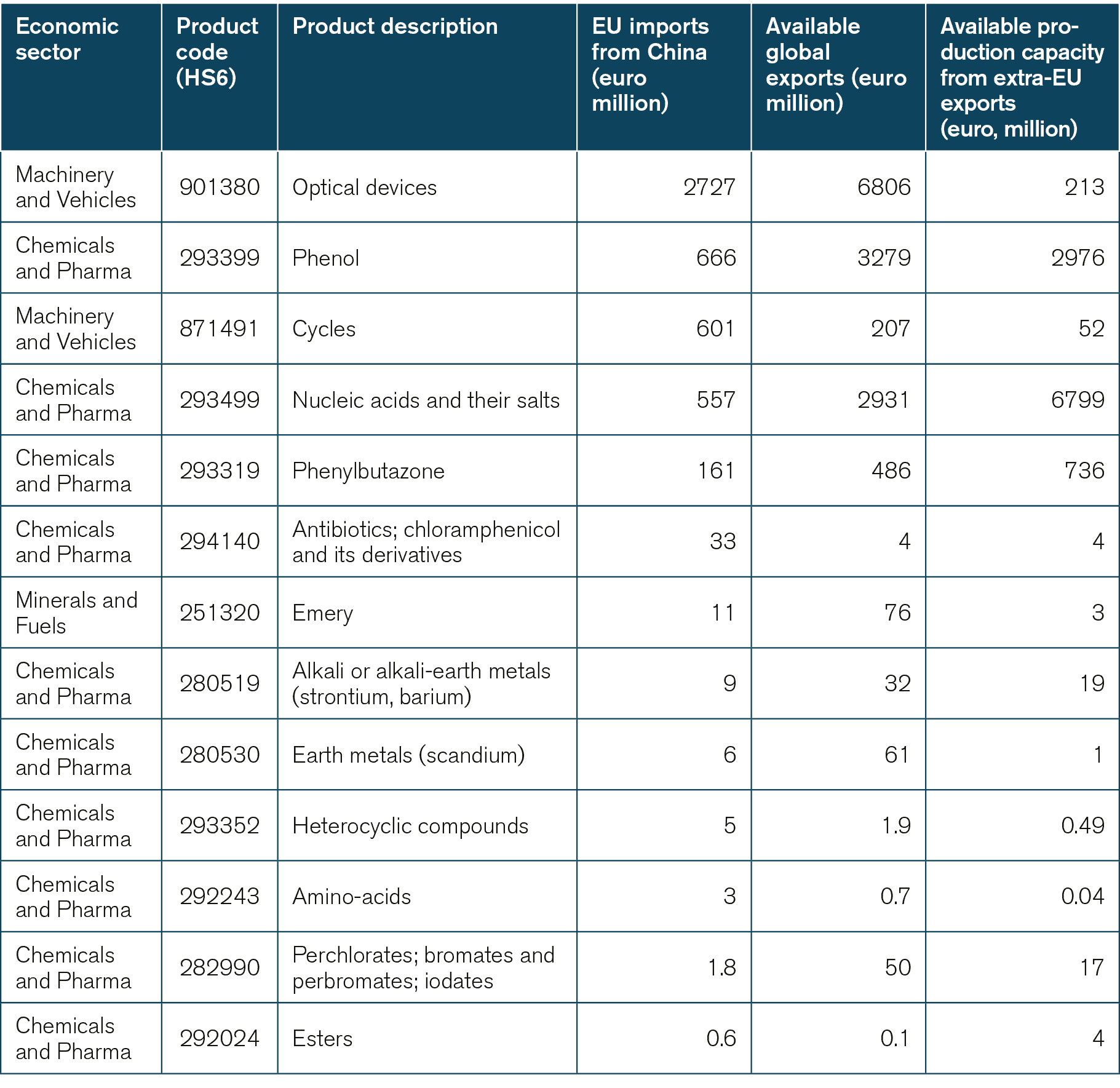 Source: UN COMTRADE, authors’ calculations. Product descriptions have been shortened.
Source: UN COMTRADE, authors’ calculations. Product descriptions have been shortened.
[1] Anderson, C., Pryser, H. (2020, April 5). Finland, ‘Prepper Nation of the Nordics,’ Isn’t Worried About Masks. The New York Times, Retrieved from: https://www.nytimes.com/2020/04/05/world/europe/coronavirus-finland-masks.html
[2] Guinea, O., & Espés, A. (2021). International EU27 pharmaceutical production, trade, dependencies and vulnerabilities: a factual analysis. Report, ECIPE.
[3] For instance, self-sufficiency in ventilators, used to treat COVID-19 patients in intensive care, would require reproducing the supply chain of 621 crucial components. Another example, the European Commission has estimated that self-sufficiency in microchips would cost between €240 and €320 billion.
[4] Statement by Federal Chancellor Merkel, Office of the German Federal Government, 6 April, 2020, https://www.bundesregierung.de/breg-de/themen/coronavirus/statement-by-federal-chancellor-merkel-1739724
[5] Guinea, O., & Forsthuber, F. (2020). Globalisation Comes to the Rescue: How Dependency Makes us More Resilient. Report, ECIPE, Brussels, occ. paper 6/2020, 18p.
[6] Guinea, O., & Forsthuber, F. (2020). Globalisation Comes to the Rescue: How Dependency Makes us More Resilient. Report, ECIPE, Brussels, occ. paper 6/2020, 18p.
[7] This analysis was done using a higher level of aggregation (six digits). UN COMTRADE presents the data in US$. This data has been converted to Euros using the average Euro-US$ exchange rate for 2020. The higher level of aggregation and the exchange rate modification means that the import values in Table 1 and in Table 2 in the Annex do not coincide.
[8] The product categories decrease from 18 to 13 when aggregated to the HS6 level in WITS.
[9] Peel, M., Sanderson, H. (2020, August 31). EU sounds alarm on critical raw materials shortages. The Financial Times. Retrieved from: https://www.ft.com/content/8f153358-810e-42b3-a529-a5a6d0f2077f
[10] The Economist (2022, January 29). Chipmaking. Party on. The Economist.
5. Conclusion
Fear of dependency supports the narrative behind the new push for a muscular EU industrial policy. It is true that the EU has strategic vulnerabilities, goods imported from only a few places, and which are not produced within the EU. However, out of close to 9,000 product categories[1], there were only 233 for which this was the case. Many of these 233 products are easy to substitute and non-strategic. Focusing new industrial support on the 1.2% of EU total imports where there are some dependency risks simply does not make sense. The EU does not need an industrial policy for lobsters and bamboo. There is no need for a ‘strategic ginseng policy’.
Stockpiling and subsidising domestic production are two policy options that the EU is pursuing to lower dependencies. Since 2020, many EU member states have built stocks of personal protective equipment to be used in case of shortages, and the EU has put forward a proposal for the European Chips Act that aims to double the production of semiconductors within the EU by 2030. Yet, the cheapest option to lower dependency is seldom discussed. Businesses can diversify their current sources of supply and the EU can carry out policies to support these actions. To encourage diversification and help swift adjustments, the EU can get rid of import tariffs and accept the regulatory processes of more countries. In the case of China, our analysis shows that EU businesses can tap into foreign production that is not currently imported into the EU to lower trade dependencies from China.
The analysis of the data shows that import dependency is a political rather than an economic problem. In the past, troubling import dependencies have been accepted – like dependency on Russia’s oil and gas – and policy changes required to create better conditions for domestic production – like allowing the mining of rare earths in Europe – have not been accepted. Most of the other product categories for which the EU is dependent can be substituted with other goods or bought from alternative suppliers. Semiconductors are a good example of the political nature of trade dependencies. The shortage of microchips comes as a result of production not being able to keep up with demand, and not because of a natural disaster that has choked supply chains in Asia. Subsidising EU production of semiconductors is a political decision, but it cannot be motivated by the fear of import dependency.
[1] A higher level of granularity is needed to understand EU’s dependency and to design policies that address EU’s dependencies in a surgical way. The work that the EU is undertaking in updating its customs union should include the measurement of EU dependencies so the EU is capable of tracking EU dependencies across products over time and is aware of the geographical location of EU importers in case of a natural disaster or a political conflict.
Annex
Table 1: List of 233 product categories in which the EU is dependent from the rest of the world (2020) *Product descriptions have been shortened.
*Product descriptions have been shortened.
Table 2: List of 51 product categories in which the EU is dependent from China (2020) *Product descriptions have been shortened.
*Product descriptions have been shortened.